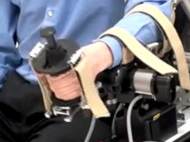Patients show progress years after stroke – robot assisted therapy
 Therapists once thought the therapeutic window closed six months after a stroke, however, a major clinical study has found that patients show modest yet meaningful gains in limb movement and an improved outlook on life years after suffering a stroke. Researchers from Brown University, lead by Albert Lo who is assistant professor of neurology, used a robot to aid the patient in limb movement.
Therapists once thought the therapeutic window closed six months after a stroke, however, a major clinical study has found that patients show modest yet meaningful gains in limb movement and an improved outlook on life years after suffering a stroke. Researchers from Brown University, lead by Albert Lo who is assistant professor of neurology, used a robot to aid the patient in limb movement.
New machine-assisted therapies suggest progress in regaining limb function may be possible even several years later. Researchers theorize that boosting arm function helped patients be more active overall, which led to wider health improvements. “We believe that by gaining more function and better control of their affected arms, patients were able to get out and do more, translating their motor benefits into additional meaningful social activity and participation,” said Lo.
The study featured a robot called the MIT-Manus, which had been tested in a few smaller trials. Users sit at a table with their affected arm attached to the device. They follow therapists’ instructions or computerized prompts and move a cursor on a screen — somewhat like a video game — and try to perform a task with their arm. The robot senses their movement and helps as needed.
“The robots provide ‘power steering’ for the arms — just enough assistance to allow people to move,” said George Wittenberg, a neurologist at the VA and the study’s lead investigator in Baltimore.
The intensive therapy tested in the study, with or without robots, takes advantage of neuroplasticity — the ability of the adult brain to “rewire” itself. When neurons die because of a stroke, other brain cells, prompted by assisted body movements, begin compensating for the lost function.
The study took place at VA medical centers in West Haven, Conn., Baltimore, Gainesville, Fla. and Seattle. The three-year randomized control trial by the U.S. Department of Veterans Affairs enrolled 127 veterans at four VA sites. All had suffered a stroke at least six months earlier and had moderate to severe impairment of an arm. On average, the strokes had occurred nearly five years before; one-third of the victims had suffered multiple strokes. Patients typically get rehabilitation therapy only during the first six months or so after a stroke. Conventional thinking has been that long-term stroke survivors cannot accrue additional meaningful benefits after that time. Recent studies, though, have begun to suggest otherwise.
The therapy involved repetitive, guided movement, three times a week, for three months. One group of patients underwent upper-limb therapy with the use of robots designed at the Massachusetts Institute of Technology. Others did similar high-intensity exercises with a therapist. At each session, the patients performed 1,024 upper-arm movements, a substantially more intense workout than in a conventional rehabilitant protrotion session. A third, smaller group had only “usual care” — they received general health care but no specific therapy for their stroke-damaged upper limb.
Patients who had 12 weeks of robot-assisted therapy showed statistically significant improved quality of life (an eight-point improvement on the Stroke Impact Scale) compared to those who had no additional therapy. At six months, patients aided by the robotic therapy showed clinically significant upper-arm function (three-point improvement on the Fugl-Meyer Scale) compared to the usual care group.









Leave your response!